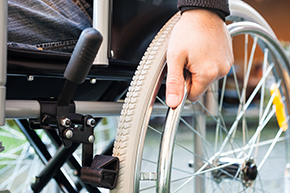Wednesday, February 11th, 2015

The implications of health informatics for people with disabilities are significant.
The subset of people with disabilities constitutes one of the largest cohorts of health care users in the population. In order to apply our knowledge of informatics most effectively, we need to fully understand the user and subject populations of our research, training and products. We need to be knowledgeable about the demographics of the population of people with disabilities, and we need to be cognizant of the subtle differences between subsets of this population.
To give you some idea as to why informatics is important to people with disabilities and why a focus on disability is vitally important for informaticians, let's look at the demographics.
Disability is the world’s largest minority group.
There are nearly a billion people with disabilities in the world today. In the United States, there are 56.7 million people with disabilities.
The Baby Boom and the health care industry technology revolution are having a dramatic impact on the disability demographic.
Today there are 76 million Baby Boomers in the US. Because of the Boomers, the over 65 population is growing at a very rapid rate. Today 44 million Americans are over 65 and by 2020, that number will increase to 56 million. Presently, 40% of all seniors have disabilities and by 2020, half of all seniors will have disabilities.
There is a correlation between disability and age that will predictably drive the population of people with disabilities up over the next few decades.
In other words: due to the rapid increase in the proportion of older persons in the population as a result of the Baby Boom, and due to increasing longevity caused by improvements in medical care, the population of people with disabilities in the US (and countries with similar demographic and techno-health dynamics), is projected to increase until about the year 2070. This will occur despite new developments in medicine, biomedical engineering and related fields that will help moderate and reduce the impact of disability.
There is a high correlation between age, disability and health care utilization.
Just think about it; the older a person is, the more likely he or she is to consume health care services. The more disabled a person is, the more likely he or she is to consume health care services. Hence, people who are elderly and disabled are much more likely to be in need of health care.
Seniors and people with disabilities want to age in place.
People want to live in their own homes, to have their own space and to keep their own things. This is generally true, regardless of age, health status or other characteristics. Too often, when people become old and/or disabled, they are forced to live in mostly segregated, communal settings, like nursing homes where they have very little privacy, virtually no control over their own schedules or what they eat or wear, and few opportunities to be with family or friends or to participate in community activities.
To provide people with the opportunity to live in the community throughout their lives (as opposed to living in institutions like nursing homes), we need to build a community-based, independent living infrastructure that will effectively and efficiently meet their needs for health care and in-home support services. Such an infrastructure will necessarily be driven by informatics.
The bottom line for informaticians:
Aside from the obvious need to consider issues pertaining to disability in our education, research, product development and service activities, there is a huge opportunity, and I would say a moral obligation, to apply our knowledge of informatics to the task of building the home and community-based infrastructure of the future. This will involve the development of monitoring and queuing technologies; design of caregiver locating, training and matching systems; creation of home-based, smart robotics; and application of advanced personal tele-medical solutions. Ultimately, our goal should be to help build an informatics-rich, supportive environment so that all of us, and our families, will be able to live in our own homes and be as independent and productive as possible throughout our lives, regardless of the challenges that aging and disability might bring.
If you would like further information or if you would like to discuss opportunities in disability informatics, please contact me at [email protected].
written by Lex Frieden

Lex Frieden is professor of health informatics and professor of physical medicine and rehabilitation at the University of Texas Health Science Center at Houston and he directs the Independent Living Research Utilization program at TIRR Memorial Hermann.